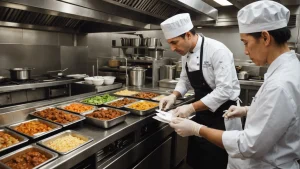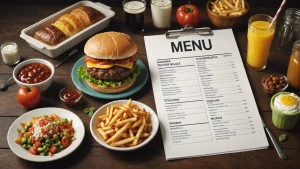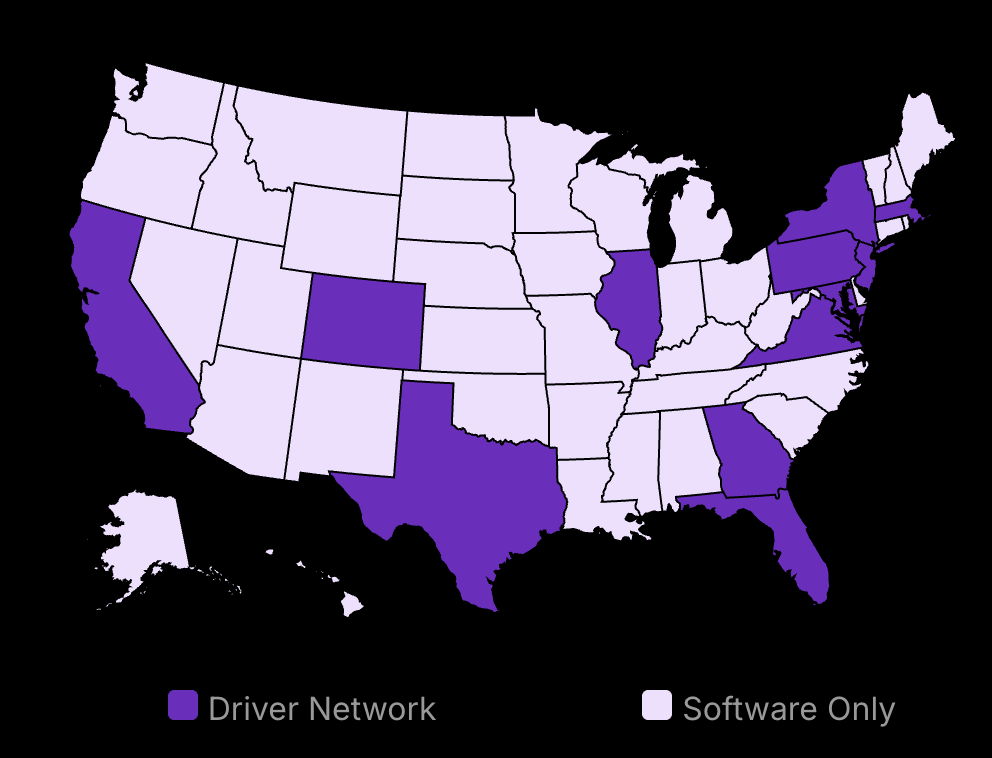Failing a health inspection can be a restaurant’s worst nightmare.
In 2025, with even stricter regulations and more frequent inspections, staying on top of health code violations is more important than ever. But here’s the good news: avoiding health code violations doesn’t have to be a daunting task.
By implementing a few simple steps, you can ensure your restaurant’s health inspection goes smoothly, maintaining a spotless record while keeping your customers safe. In this blog post, we’ll walk you through 7 easy-to-follow strategies to prevent the most common health code violations.
From proper food storage and handling to employee hygiene best practices, we’ve got you covered. Let’s dive in and learn how to keep your restaurant in tip-top shape and in compliance with health regulations in 2025 and beyond.

Save 80% of delivery management time
We handle everything:
- Dedicated operations manager
- Real-time tracking dashboard
- Automated customer notifications
- Urgent issue resolution
Common Health Code Violations and How to Prevent Them
Common Health Code Violations:
Common non-critical violations include non-food contact surface maintenance, plumbing and adequate toilet facilities, pest and animal control, and use of utensils and linens.
Improper Food Storage and Handling
Storing and handling food correctly is crucial to preventing foodborne illnesses in your restaurant. One of the most important aspects of proper food storage is maintaining the correct temperature. Cold foods should be stored at or below 40°F (4°C), while hot foods should be refrigerated foods kept at or above 140°F (60°C). This temperature range, known as the “danger zone,” is where harmful bacteria can quickly multiply, leading to potential health hazards.
To ensure food safety, use separate cutting boards and utensils for raw and cooked foods. This practice helps prevent cross-contamination, which occurs when harmful bacteria from raw foods transfer to the ready to eat food not-to-eat items. Color-coded cutting boards can be an effective way to differentiate between those used for raw meat, poultry, and seafood, and those used for produce and cooked foods.
Proper Food Labeling and Storage Containers
Proper labeling of food items is another essential aspect of food safety. Labels should include the name of the food, the date it was prepared or received, and the expiration date. This information helps kitchen staff rotate stock and use items before they spoil (for example raw chicken expires quickly), reducing the risk of serving contaminated food to customers. Common food storage mistakes usually include expiration dates. Moreover, the revised FDA Menu Labeling Rule requires restaurants to provide calorie counts and other nutritional information, an adjustment that could influence your food choices while dining out.
When storing food, use appropriate containers that are designed for food storage and are made of food-grade materials. Containers should have tight-fitting lids to prevent contamination and maintain freshness. Regularly inspect storage containers for signs of wear, such as cracks or chips, and replace them as needed.
The Temparature
Keeping refrigerated foods at or below 39°F and frozen foods at or below 0°F helps maintain food freshness and safety. Labeling food items with name, date of preparation, and expiration date helps track freshness and prevent spoilage.
Poor Personal Hygiene Practices
Maintaining high standards of personal hygiene among your restaurant staff is essential to preventing the spread of illness and ensuring food safety. Train your employees on proper handwashing techniques, which include using warm water, soap, and scrubbing for at least 20 seconds. Handwashing should occur before handling food, after using the restroom, after touching raw food, and after handling money or dirty dishes.
In addition to handwashing, enforce the use of gloves and hairnets when handling food. Nitrile gloves provide an extra layer of protection against the transfer of bacteria from hands to food, while hairnets keep hair from falling into food and prevent the spread of bacteria from the scalp.
Employee Health and Illness Prevention
Encourage your employees to stay home when they are sick to prevent the spread of illness to coworkers and customers and also, supply them with personal protective equipment. Develop a clear policy on employee health, which should include guidelines on when employees should stay home and when they can return to work after an illness.
Regular employee training on food safety and personal hygiene practices is crucial to maintaining a safe and healthy restaurant environment. Conduct training sessions for new hires and provide ongoing education for all staff members to reinforce best practices and keep food safety top of mind.
By focusing on proper food storage and handling, as well as maintaining high standards of personal hygiene among your staff, you can significantly reduce the risk of health code violations in your restaurant. In the next section, we’ll explore how to implement these and other food safety best practices to ensure your restaurant remains compliant and your customers stay safe.
Prevention of Health Code Violations:
Implementing proper food safety systems, ensuring regular sanitation practices, and using proper food handling techniques can help prevent health code violations.

Metrobi is transforming catering deliveries
Specialized solutions for catering businesses:
- Catering-trained drivers
- Proper handling equipment
- Peak day delivery support
- 23% average cost reduction
Implementing Food Safety Best Practices in Your Restaurant
Develop a Comprehensive Food Safety Plan
Creating a detailed food safety plan is the foundation of maintaining a clean, safe, and compliant restaurant. This plan should include written procedures for every aspect of food preparation, storage, and handling. Start by outlining the steps involved in each process, from receiving ingredients to serving customers. Be sure to include specific guidelines for temperature control, cross-contamination prevention, and personal hygiene.
Next, establish a cleaning and sanitizing schedule and a restaurant cleaning checklist e for all equipment and surfaces. This cleaning solution should include daily, weekly, and monthly tasks, as well as procedures for deep cleaning and maintenance. Assign responsibilities to specific team members and ensure that they have the necessary tools and supplies to complete their tasks effectively.
Task Frequency Responsible Party
Clean and sanitize kitchen surfaces Daily Kitchen Staff
Clean and sanitize equipment Weekly Kitchen Staff
Deep clean and maintain equipment Monthly Maintenance Team
Finally, regularly review and update your food safety plan to ensure ongoing compliance with local health codes. Stay informed about any changes to regulations and adjust your procedures accordingly. Conduct periodic self-inspections to identify and address any potential issues before they become violations.
Invest in Employee Training and Education
Proper employee training and education are critical to maintaining high standards of food safety and hygiene in your restaurant. Begin by providing comprehensive training sessions for all new hires, covering topics such as handwashing, glove use, temperature control, and cross-contamination prevention. Use a combination of written materials, videos, and hands-on demonstrations to ensure that employees fully understand and retain the information.
Encourage Open Communication and Reporting
Encourage open communication among your team members and create a culture where employees feel comfortable reporting any potential health code violations or concerns. Regularly remind staff that their input is valued and that addressing issues promptly is essential to maintaining a safe and compliant restaurant.
Conduct Periodic Assessments
Conduct periodic assessments to ensure that employees are following proper procedures. Use a checklist to evaluate food safety practices, such as handwashing technique, food storage methods, and cleaning and sanitizing procedures. Provide immediate feedback and additional training as needed to correct any deficiencies.
Establish a Robust System for Monitoring and Maintaining Proper Food Storage and Handling
Proper food storage and handling practices are essential to preventing the most common health violation in restaurants: improper holding temperatures. Establish a robust system for monitoring and maintaining appropriate temperatures for all food items, from receiving to serving.
Invest in Accurate Temperature Monitoring Equipment
Invest in accurate, calibrated thermometers for all refrigerators, freezers, and other hot food- holding units. Assign staff members to regularly check and record temperatures, ensuring that cold foods are held at 41°F (5°C) or below and hot foods are held at 135°F (57°C) or above.
Average Costs for Advanced Temperature Monitoring Systems:
These can include a combination of sensors, data loggers, and software for monitoring and recording temperatures. The cost can range from $1,000 to $5,000 or more, depending on the complexity and features of the system.
Use the First-In, First-Out (FIFO) Method for Food Rotation
Implement the First-In, First-Out (FIFO) method for food rotation to minimize waste and ensure that older items are used before newer ones. Label all food containers with the date they were prepared or received, and organize storage areas so that older items are easily accessible.
By developing a comprehensive food safety plan, investing in employee training and education, and establishing a robust system for monitoring and maintaining proper food storage and handling practices, you can significantly reduce the risk of health code violations in your restaurant. These best practices will help ensure that your establishment remains clean, safe, and compliant, while providing a high-quality dining experience for your customers.
Benefits
The FIFO method can help reduce carrying costs as products move faster, and decrease storage expenses and potential obsolescence costs, making it a cost-effective inventory management strategy. In sectors like food and pharmaceuticals, FIFO stock rotation is mandated to ensure product freshness and food safety, emphasizing the importance of adhering to this method in regulated industries.
The Importance of Proper Food Storage and Handling in Restaurants
Temperature Control
Maintaining proper food temperatures is crucial for preventing the growth of harmful bacteria and ensuring food safety. Restaurants must keep refrigerators and freezers at the appropriate temperatures, typically between 32°F and 40°F for refrigerators and 0°F or below for freezers. Understanding the FDA Menu Labeling Rule is essential as it impacts how eateries need to share nutrition and safety information, which might influence your decision on where and what to eat.
Monitoring Temperatures
Regularly checking food temperatures during storage and preparation using accurate thermometers is essential. Hot foods should be held at a minimum of 140°F, while cold foods must be kept at 40°F or below. Monitoring temperatures helps identify potential issues before they lead to health code violations.
Temperature Logs
Maintaining temperature logs is a best practice that demonstrates compliance and helps identify trends or problems. Assign staff to record temperatures at regular intervals throughout the day, ensuring that all cold storage, units and holding areas are checked.
Preventing Cross-Contamination
Cross-contamination occurs when harmful bacteria from raw foods, such as meats, poultry, and seafood, transfer to ready-to-eat foods, surfaces, or equipment. Preventing cross-contamination is vital for maintaining food safety and avoiding health code violations.
Proper Storage Practices
Store raw meats, poultry, and seafood separately from ready-to-eat foods in refrigerators and freezers. Use designated shelves or areas to prevent juices from dripping onto other foods.
Designated Equipment
Use designated cutting boards, utensils, and equipment for different food types to prevent cross-contamination. Color-coded cutting boards can help staff easily identify which equipment to use for specific tasks.
Cleaning and Sanitizing
Clean and sanitize all equipment cleaning supplies and surfaces between uses, especially when switching from raw to ready-to-eat foods. Follow proper cleaning and sanitizing procedures, using approved chemicals at the correct concentrations.
High rates of cross-contamination in restaurants:
A CDC study found that over 800 foodborne illness outbreaks are reported annually, with 60% linked to restaurants. This highlights the importance of proper food handling and cross-contamination prevention in these establishments.Types of cross-contamination:
There are three main types: food to food, utensil to food, and people to food. These types can occur through direct contact, juice transfer, or improper cleaning and sanitizing.
FIFO Inventory Management
First-In, First-Out (FIFO) inventory management ensures that older products are used before newer ones, reducing the risk of spoilage and foodborne illness. Implementing a FIFO system helps restaurants maintain food quality and safety while minimizing waste.
Labeling and Dating
Label all food items with the date they were received or prepared, and use the oldest products first. This practice helps staff easily identify which items need to be used first, reducing the risk of serving expired or spoiled food.
Proper food storage and handling are essential components of maintaining health code compliance in restaurants. By focusing on temperature control, cross-contamination prevention, and FIFO inventory management, restaurants can protect their customers, maintain their reputation, and avoid costly health code violations.
The Role of Restaurant Employee Hygiene in Maintaining Health Code Compliance
Employee hygiene directly impacts food safety and health code compliance
Proper handwashing and personal hygiene practices prevent the spread of foodborne illnesses
Restaurants must provide training and resources to ensure employees maintain high hygiene standards
Proper Handwashing Techniques
Handwashing is the most effective way to prevent the spread of harmful bacteria and viruses in a restaurant setting. Employees should wash their hands with soap and warm water for at least 20 seconds, paying attention to the areas between fingers, under fingernails, and the backs of hands. Handwashing should be done before handling food, after using the restroom, and after touching any potentially contaminated surfaces, such as garbage bins or dirty dishes.
Handwashing Stations
Restaurants must provide easily accessible handwashing stations for employees, complete with soap, warm water, and disposable paper towels. These stations should be separate from food preparation areas and be kept clean and well-stocked at all times. Encouraging employees to use handwashing stations frequently throughout their shifts can significantly reduce the risk of foodborne illness outbreaks.
27% of food service workers wash their hands as required:
A study by the CDC found that food service workers only washed their hands in 27% of the activities they were supposed to, highlighting the need for better handwashing practices.
Personal Hygiene Practices
In addition to proper handwashing, restaurant employees must maintain good personal hygiene practices to ensure food safety and health code compliance. This includes wearing clean uniforms and aprons, which should be changed daily or more frequently if they become soiled. Employees should also be prohibited from eating, drinking, or smoking in food preparation areas to minimize the risk of contamination.
Grooming and Health
Employees should be encouraged to maintain good personal hygiene, including regular bathing and grooming. This means keeping hair clean and tied back, trimming fingernails, and avoiding strong perfumes or colognes that may interfere with food odors. Additionally, employees who are ill or have open wounds should not be allowed to work in food preparation areas until they have fully recovered to prevent the spread of illness to customers.
Employee Training and Education
Proper employee hygiene practices are only effective if employees understand their importance and how to implement them correctly. Restaurant managers should provide regular training and education sessions to ensure all employees are aware of the latest health code requirements and best practices for maintaining hygiene in the workplace.
Training Topics
Training sessions should cover topics such as proper handwashing techniques, personal hygiene practices, and the dangers of foodborne illnesses. Employees should also be trained on how to recognize signs of food contamination and what steps to take if they suspect a potential health code violation. By investing in employee education, restaurants can create a culture of food safety and hygiene that benefits both employees and customers.
Monitoring and Enforcement
To ensure that employee hygiene practices are consistently maintained, restaurant managers must implement a system of monitoring and enforcement. This may include regular inspections of handwashing stations and employee uniforms, as well as random checks to ensure that employees are following proper hygiene protocols.
Consequences for Non-Compliance
Employees who fail to comply with hygiene standards should face consequences, such as verbal warnings, written reprimands, or even termination in severe cases. By enforcing strict hygiene policies, restaurants can demonstrate their commitment to food safety and health code compliance, which can help build trust with customers and prevent costly violations.
The Benefits of Good Employee Hygiene
Maintaining high standards of employee hygiene not only helps restaurants avoid health code violations but also offers several other benefits. When employees practice good hygiene, they are less likely to spread illness to their coworkers, which can reduce absenteeism and improve overall productivity. Additionally, customers are more likely to trust and return to restaurants that demonstrate a commitment to cleanliness and food safety.
By prioritizing employee hygiene and providing the necessary resources and training, restaurants can create a safer, more successful business that is well-prepared to meet the challenges of maintaining health code compliance in the competitive food service industry.
Understanding Restaurant Health Inspections and Compliance
The Role of Local Health Departments
Local health departments play a vital role in their restaurant health inspectors ensuring restaurants maintain a safe and hygienic environment for their customers. Health inspectors, employed by these departments, conduct regular inspections to assess compliance with health codes and identify potential violations. The frequency of these inspections varies based on factors such as the restaurant’s risk level and past compliance history.
During an inspection, a health inspector will thoroughly evaluate the restaurant’s food safety practices, sanitation procedures, and employee hygiene. They will check for proper food storage and handling, cooking temperatures, cleanliness of equipment and surfaces, and the overall condition of the establishment. Any violations or areas of concern will be noted, and the inspector will provide guidance on how to rectify these issues.
The relationship between restaurants and local health departments should be one of collaboration and open communication. Restaurant owners and managers should view health inspectors as partners in ensuring public health and safety protocols rather than adversaries. By working together and addressing concerns promptly, restaurants can maintain a high level of compliance and build a positive reputation within their community.
Preparing for Health Inspections
Maintaining Accurate Records
One of the key aspects of preparing for health inspections is maintaining accurate records of food safety procedures and employee training. These records serve as evidence of the restaurant’s commitment to compliance and can be invaluable during an inspection. Important documents to keep on hand include:
Food temperature logs
Cleaning and sanitation schedules
Employee training records
Pest control reports
By organizing and updating these records regularly, restaurants can demonstrate their adherence to health codes and quickly address any questions or concerns raised by inspectors.
70% of Diners Are Deterred by Health Code Violations:
70% of diners are unwilling to visit restaurants that violate health codes, highlighting the significant impact of health code violations on customer choice.Restaurant Health Code Violations Affect Both Customer Safety and Business Success:
Restaurants with better hygiene grades tend to have higher sales, emphasizing the importance of adhering to health codes for both customer safety and business success.
Conducting Regular Self-Inspections
In addition to maintaining accurate records, restaurants should conduct regular self-inspections to identify and correct potential issues before they become significant problems. These self-inspections should be thorough and cover all areas of the establishment, from the kitchen to the dining room.
When conducting a self-inspection, consider using a checklist that covers key areas such as:
Food storage and handling
Cooking temperatures
Equipment cleanliness and maintenance
Employee hygiene practices
Pest control measures
By proactively identifying and addressing issues, restaurants can minimize the risk of violations during official health inspections.
Encouraging Open Communication with Health Inspectors
Fostering open communication with health inspectors is crucial for maintaining compliance and building a positive working relationship. Restaurant owners and managers should encourage their staff to be transparent and cooperative during inspections, answering questions honestly and providing any requested documentation.
If an inspector identifies a violation or area of concern, it is essential to address the issue promptly and thoroughly. This may involve implementing new procedures, providing additional training to employees, or making necessary repairs or upgrades to the establishment. By demonstrating a willingness to work with inspectors and a commitment to correcting violations, restaurants can build trust and credibility with their local health department.
Navigating Health Code Regulations for Restaurant Owners and Managers
Familiarizing Yourself with Local Health Codes
As a restaurant owner or manager, it’s crucial to have a thorough understanding of the local health code regulations that apply to your establishment. Start by obtaining a copy of these regulations from your local health department or online resources. Take the time to review the regulations carefully, paying close attention to sections that are most relevant to your restaurant’s operations. To ensure your restaurant can also serve alcohol, it’s important to understand the process for obtaining an alcohol permit. Learn the essentials of acquiring an alcohol license, including the various types available and the steps involved in making your establishment compliant.
Regularly review the health code regulations to ensure ongoing compliance. Consider attending training sessions or workshops offered by your local health department to gain a deeper understanding of the regulations and best practices for compliance. These sessions can provide valuable insights into common most common health code violations and how to prevent them.
Are Restaurant Owners Required to Know All Local Health Codes?
While it’s not necessary to memorize every detail of the local health codes, restaurant owners and managers are responsible for ensuring their establishment complies with all applicable regulations. Ignorance of the law is not an excuse for violations. It’s essential to have a working knowledge of the key areas of the health code that apply to your restaurant, such as food safety, sanitation, and employee hygiene.
Frequency of Health Code Violations:
Restaurants are more likely to have behavioral and critical violations than schools, with odds ratios indicating that restaurants are 3.6 times more likely to have behavioral violations and 3.0 times more likely to have critical violationsConsequences of Health Code Violations:
In the United States, health inspectors issue inspection reports graded on a letter or number-based score. Each violation reduces a restaurant's public health rating, and severe health hazards can result in fines or even temporary closure
Staying Up-to-Date with Changes in Health Code Regulations
Health code regulations can change over time, so it’s important to stay informed about any updates or revisions. Regularly monitor communication from your local health department, such as newsletters, emails, or websites, to stay abreast of any changes. When changes occur, promptly communicate them to your employees and adjust your procedures as necessary to maintain compliance.
If you’re unsure about how a specific change affects your restaurant, don’t hesitate to reach out to your local health department officials for guidance and clarification. Building a positive relationship with these officials can be beneficial, as they can provide valuable advice and support in navigating the complexities of health code regulations.
Developing a System for Implementing and Maintaining Health Code Standards
To ensure consistent compliance with health code regulations, it’s essential to develop a system for implementing and maintaining standards within your restaurant. This system should include regular staff training on food safety, sanitation, and hygiene practices. Consider designating a staff member as a food safety manager, responsible for overseeing compliance efforts and serving as a point of contact for health inspectors.
Create checklists and standard operating procedures (SOPs) that outline the specific steps employees must follow to maintain compliance with health codes. These documents should cover areas such as food storage, preparation, cooking temperatures, and cleaning and sanitizing procedures. Regularly review and update these materials to reflect any changes in regulations or best practices.
Frequency of Health Inspections
The frequency of health inspections can vary depending on your location and the type of establishment you operate. In general, restaurants can expect to be inspected at least twice a year, with further follow up inspection make-up inspections required if critical violations are found. It’s important to note that health inspectors have the authority to enter your restaurant at any time during normal business hours to conduct an inspection, even without prior notice.
By familiarizing yourself with local restaurant health codes beforehand, staying up-to-date with changes, and developing a system for maintaining compliance, you can navigate the complex world of health code regulations with confidence. In the next section, we’ll address some common questions about restaurant health code violations and how to avoid them.
Inspection Frequency and Food Safety Compliance:
A study found that the frequency of inspections significantly affects food safety compliance. Restaurants with more frequent inspections had fewer noncompliances and better food safety practices.Impact of Inspection Frequency on Foodborne Illness:
Another study found that increasing the frequency of inspections in high-risk restaurants did not significantly reduce foodborne illness rates. However, it did improve food safety practices and compliance.
Addressing Common Questions About Restaurant Health Code Violations
What are the consequences of health code violations?
The consequences of health code violations can vary depending on the severity and frequency of the infractions. Minor violations, such as a one-time incident of improper food storage, may result in a warning or a requirement to take corrective action within a specified timeframe. However, severe or repeated violations can lead to more serious consequences. “Restaurants that consistently fail to meet health code standards may face fines, temporary closures, or even the loss of their operating permits,” warns Sarah Johnson, a public health inspector with the local health department.
How can restaurants maintain compliance between health inspections?
Maintaining compliance with health code regulations requires ongoing effort and vigilance from restaurant owners and managers. One of the most important steps is to foster a strong food safety culture within the establishment.
“Regular employee training and education on proper food handling practices is essential for maintaining compliance,” advises Michael Brown, a restaurant consultant who has helped numerous businesses improve their own food safety policies and protocols. “Managers should also conduct frequent self-inspections to identify and address any potential issues before they become violations.”
By understanding the answers to these common questions about restaurant health code violations, owners and managers can take proactive steps to ensure their establishments remain in compliance with regulations and avoid the consequences of non-compliance. Implementing a strong food safety culture, conducting regular self-inspections, and maintaining open communication with employees are all essential strategies for success in this area. By mastering restaurant food safety principles, businesses can uphold hygiene standards and safeguard the wellbeing of their patrons.
Safeguarding Your Restaurant’s Reputation and Customer Health
Maintaining a clean, safe, and compliant restaurant is crucial for the well-being of your customers and the success of your business. By implementing proper food storage and handling practices, investing in employee training, and staying up-to-date with local health codes, you can avoid costly violations and protect your restaurant’s reputation.
Remember, the key to success lies in creating a strong food safety culture within your establishment. Encourage open communication among your staff, conduct regular self-inspections, and address any potential issues promptly. By doing so, you’ll be well-prepared for health inspections and can maintain compliance between visits.
Are you confident in your restaurant’s current food safety practices? Take a moment to review your procedures and identify any areas that may need improvement. Small changes, like updating your employee training program or reorganizing your food storage areas, can make a significant impact on your overall compliance.
By prioritizing food safety and hygiene, you’ll not only avoid health code violations but also demonstrate your commitment to providing a top-quality dining experience for your customers. So, take action today and ensure your restaurant is ready to meet the challenges of 2024 and beyond.




























